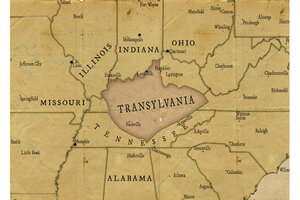Find of the Month: Two compulsively readable books about geography
History, geography, and trivia buffs should not miss these books.

"Lost States" profiles wannabe states like Transylvania, which Daniel Boone tried to establish as the 14th state.
"Lost States"
Want to find out where you are? Check an atlas. Want to figure out how your state ended up on the map in the first place and avoided becoming, say, Franklin, Acadia, or West Kansas? Head to the bookstore and crack open these two entertaining books.
"How the States Got Their Shapes," by Mark Stein
Check a map of the United States and you'll find a whole bunch of weird-looking states.
Some are simple rectangles, like Wyoming and Colorado. That makes sense. But what about the panhandles in Oklahoma and Florida? (Maybe a cartographer was feeling a bit peckish.) The weird little notches in Missouri and Connecticut? And the itty-bitty stretch of Maryland between Pennsylvania and West Virginia?
And don't even get us started about Michigan's Upper Peninsula. Shouldn't a state be all in one piece?
Good questions, and you'll find good answers in 2008's "How the States Got Their Shapes."
The author explains the borders of every state and finds that they're not always the product of common sense. Many owe their existence to blood-boiling land disputes, boneheaded surveying errors, and other accidents of history.
By the way, "How the States Got Their Shapes" inspired a nifty History Channel documentary that aired earlier this year. You can buy a copy on DVD or wait for it to air again.
"Lost States: True Stories of Texlahoma, Transylvania and Other States That Never Made It," by Michael J. Trinklein
Franklin. West Kansas. Acadia. Montezuma, Navajo, and Deseret. Not to mention Yazoo, Absaroka, and the sadly nonremembered Forgottonia.
If history had unfolded a bit differently, you might be living in one of these wannabe states, some of which had some actual basis in reality. Their stories are told in this amusing and lavishly illustrated 2010 book.
Germans wanted to create a state of their own – Adelsverein – in central Texas. New Mexico and Arizona would have become horizontal states if it wasn't for Northern hatred of Confederate leader Jefferson Davis. And my own fair city, San Diego, was claimed in the 19th century by both the distant Mormons in Salt Lake City and by landowning aristocrats who wanted to break off from that pesky legislature in Sacramento and create a state of their own to be called… Colorado.
There are many more stories in the book, including one about how the area around Wilkes-Barre, Pa., almost became part of a state to be called either Westmoreland or Wyoming. It even had a governor and a military chief named Ethan Allen. Yes, that one.
As the book notes, Allen didn't have anything to do with furniture. Or home decorating for that matter. But he did help found the state of Vermont, which had earlier declared itself to be a country called New Connecticut and which remained independent until 1791, even braving a congressional call for its invasion.
But that's another (state) story.
Randy Dotinga regularly reviews books for the Monitor.
